SNHG16 upregulation-induced positive feedback loop with YAP1/TEAD1 complex in Colorectal Cancer cell lines facilitates liver metastasis of colorectal cancer by modulating CTCs epithelial-mesenchymal transition
- PMID: 36147462
- PMCID: PMC9461660
- DOI: 10.7150/ijbs.73438
SNHG16 upregulation-induced positive feedback loop with YAP1/TEAD1 complex in Colorectal Cancer cell lines facilitates liver metastasis of colorectal cancer by modulating CTCs epithelial-mesenchymal transition
Abstract
Circulating tumor cells (CTCs) are important precursors of colorectal cancer (CRC) metastasis. The epithelial-mesenchymal transition (EMT) process facilitates CTC invasion by allowing these cells to evade antimetastatic checkpoints to mediate distant metastasis. However, the specific molecular mechanism of tumor EMT remains largely unknown. Based on our previous research on the YAP1 pathway, we further studied the upstream molecule small nucleolar RNA host gene 16 (SNHG16), whose expression was correlated with advanced TNM stage, distant metastasis, and poor prognosis in CRC patients. Furthermore, loss- and gain-of-function assays revealed that SNHG16 promoted CRC colony formation, proliferation, migration, invasion, EMT, mesenchymal-like CTC generation, and liver metastasis through YAP1. Mechanistically, SNHG16 acted as a miRNA sponge to sequester miR-195-5p on Ago2, thereby protecting YAP1 from repression. Moreover, YAP1 bound TEA domain transcription factor 1 (TEAD1) to form a YAP1/TEAD1 complex, which in turn bound two sites in the promoter of SNHG16 and regulate SNHG16 transcription. Finally, in vivo experiments showed that the inhibition of SNHG16 suppressed tumor progression, and that YAP1 rescued the effect of SNHG16 on tumor progression. Herein, we have clarified a hitherto unexplored SNHG16-YAP1/TEAD1 positive feedback loop, that may be a candidate target for CRC treatment.
Keywords: CTCs; EMT; SNHG16; TEAD1; YAP1.
© The author(s).
Conflict of interest statement
Competing Interests: We declare that we do not have any commercial or associative interest that represents a conflict of interest in connection with this work.
Figures
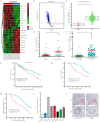
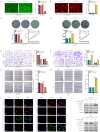

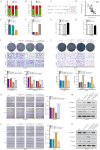

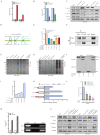
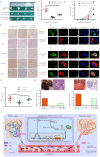
Similar articles
-
SNHG16 as the miRNA let-7b-5p sponge facilitates the G2/M and epithelial-mesenchymal transition by regulating CDC25B and HMGA2 expression in hepatocellular carcinoma.J Cell Biochem. 2020 Mar;121(3):2543-2558. doi: 10.1002/jcb.29477. Epub 2019 Nov 7. J Cell Biochem. 2020. PMID: 31696971
-
YAP1-induced MALAT1 promotes epithelial-mesenchymal transition and angiogenesis by sponging miR-126-5p in colorectal cancer.Oncogene. 2019 Apr;38(14):2627-2644. doi: 10.1038/s41388-018-0628-y. Epub 2018 Dec 10. Oncogene. 2019. Retraction in: Oncogene. 2023 Aug;42(35):2657. doi: 10.1038/s41388-023-02794-4. PMID: 30531836 Free PMC article. Retracted.
-
Long noncoding RNA RP11-757G1.5 sponges miR-139-5p and upregulates YAP1 thereby promoting the proliferation and liver, spleen metastasis of colorectal cancer.J Exp Clin Cancer Res. 2020 Oct 6;39(1):207. doi: 10.1186/s13046-020-01717-5. J Exp Clin Cancer Res. 2020. PMID: 33023613 Free PMC article.
-
Roles of long non‑coding RNA SNHG16 in human digestive system cancer (Review).Oncol Rep. 2024 Aug;52(2):106. doi: 10.3892/or.2024.8765. Epub 2024 Jun 28. Oncol Rep. 2024. PMID: 38940337 Free PMC article. Review.
-
SNHG16: A Novel Long-Non Coding RNA in Human Cancers.Onco Targets Ther. 2019 Dec 31;12:11679-11690. doi: 10.2147/OTT.S231630. eCollection 2019. Onco Targets Ther. 2019. PMID: 32021246 Free PMC article. Review.
Cited by
-
Mechanism of lncRNA SNHG16 on kidney clear cell carcinoma cells by targeting miR-506-3p/ETS1/RAS/ERK molecular axis.Heliyon. 2024 Apr 26;10(9):e30388. doi: 10.1016/j.heliyon.2024.e30388. eCollection 2024 May 15. Heliyon. 2024. PMID: 38756581 Free PMC article.
-
Noncoding RNAs as mechanistic regulators and therapeutic modulators of YAP/TAZ signaling in colorectal cancer.Med Oncol. 2025 Jul 21;42(8):357. doi: 10.1007/s12032-025-02934-8. Med Oncol. 2025. PMID: 40690071 Review.
-
Pan-cancer analysis identifies NT5E as a novel prognostic biomarker on cancer-associated fibroblasts associated with unique tumor microenvironment.Front Pharmacol. 2022 Dec 7;13:1064032. doi: 10.3389/fphar.2022.1064032. eCollection 2022. Front Pharmacol. 2022. PMID: 36569293 Free PMC article.
-
Hippo/YAP signaling pathway in colorectal cancer: regulatory mechanisms and potential drug exploration.Front Oncol. 2025 Jun 19;15:1545952. doi: 10.3389/fonc.2025.1545952. eCollection 2025. Front Oncol. 2025. PMID: 40612350 Free PMC article. Review.
-
The implication of necroptosis-related lncRNAs in orchestrating immune infiltration and predicting therapeutic efficacy in colon adenocarcinoma: an integrated bioinformatic analysis with preliminarily experimental validation.Front Genet. 2023 Aug 2;14:1170640. doi: 10.3389/fgene.2023.1170640. eCollection 2023. Front Genet. 2023. PMID: 37600653 Free PMC article.
References
-
- Siegel RL, Miller KD, Fuchs HE, Jemal A. Cancer statistics, 2022. CA: a cancer journal for clinicians. 2022;72:7–33. - PubMed
-
- Miller KD, Nogueira L, Mariotto AB, Rowland JH, Yabroff KR, Alfano CM. et al. Cancer treatment and survivorship statistics, 2019. CA: a cancer journal for clinicians. 2019;69:363–85. - PubMed
-
- Torre LA, Bray F, Siegel RL, Ferlay J, Lortet-Tieulent J, Jemal A. Global cancer statistics, 2012. CA: a cancer journal for clinicians. 2015;65:87–108. - PubMed
-
- van de Velde CJ, Boelens PG, Borras JM, Coebergh JW, Cervantes A, Blomqvist L. et al. EURECCA colorectal: multidisciplinary management: European consensus conference colon & rectum. Eur J Cancer. 2014;50:1. e- e34. - PubMed
Publication types
MeSH terms
Substances
LinkOut - more resources
Full Text Sources
Medical

